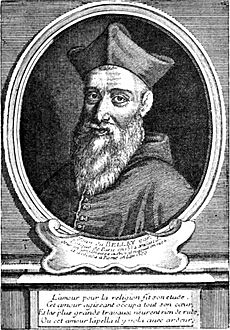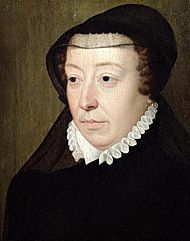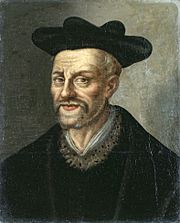Jean du Bellay facts for kids
Quick facts for kids His Eminence Jean du Bellay |
|
|---|---|
| Cardinal-Bishop | |
 |
|
| Church | Santa Cecilia in Trastevere San Pietro in Vincoli San Crisogono |
| Diocese | Paris (1532–1560) |
| See | Albano (1550–1553) Tusculum (1553) Porto (1553–1555) Ostia (1555–1560) |
| Orders | |
| Created Cardinal | 21 May 1535 |
| Personal details | |
| Born | 1492 Souday, Anjou, France |
| Died | 16 February 1560 (aged 67–68) Rome, Papal States |
| Buried | Sma. Trinità dei Monti |
| Nationality | French |
| Residence | Paris |
| Parents | Louis du Bellay Marguerite de la Tour-Landry |
| Occupation | Diplomat |
| Education | Licenciate in Canon and Civil Law |
| Alma mater | Sorbonne (?) |
Jean du Bellay (born 1492 – died 16 February 1560) was an important French diplomat and a cardinal. He was the younger brother of Guillaume du Bellay and a cousin and supporter of the famous poet Joachim du Bellay.
Jean du Bellay became a bishop in Bayonne by 1526. He was also a member of the King's special council, called the Conseil privé, for King Francis I starting in 1530. Later, he became the bishop of Paris in 1532. By 1555, he was named Bishop of Ostia and the Dean of the College of Cardinals, which was a very high position in the Catholic Church.
Contents
Jean du Bellay's Early Life and Education
Jean du Bellay was born in a place called Souday in France. He was one of six sons born to Louis du Bellay and Marguerite de la Tour-Landry. The family's main land, called Bellay, was located near Saumur.
He probably studied in Paris, though some think he might have gone to the University of Angers. He earned a special degree called in utroque iure, which meant he was an expert in both civil law (laws of the country) and canon law (laws of the Church).
Jean du Bellay was a priest in the Le Mans area. King Francis I chose him to be the Bishop of Bayonne. This choice was approved by Pope Clement VII in 1524. He served as Bishop of Bayonne until 1532, when he moved to lead the diocese of Paris. In 1533, Pope Clement allowed Bishop du Bellay to hold several important Church positions at once. King Francis confirmed this special permission in 1534.
Later, in 1551, Jean du Bellay was replaced as Bishop of Paris by his nephew, Eustache. This happened after King Henry II removed Cardinal Jean from the position.
A Diplomat for France in England
Jean du Bellay was very good at being a diplomat, which means representing his country in other nations. He went on several important missions to England between 1527 and 1534.
He was the main French Ambassador in England from November 1527 to February 1529. His older brother, Guillaume, then took his place. Jean returned as Ambassador from May 1529 to January 1530. He also went back for shorter missions in 1530, 1531, and 1532.
In October 1532, Jean du Bellay was present at a meeting between the English and French kings in Boulogne. After this meeting, other cardinals were sent to Rome to talk with Pope Clement VII. Du Bellay himself returned to England from November 1533 to January 1534. His job during this last trip was to explain new agreements made between King Francis I and Pope Clement VII.
Important Missions in Rome
After his time in England, Jean du Bellay was sent as a special Ambassador to the Pope's court in Rome. This mission lasted from January to May 1534. His main goal in both England and Rome was to stop Pope Clement from taking strong action against Henry VIII of England. King Henry was an important friend to France against the Emperor Charles V.
One of the people who traveled with du Bellay to Rome was François Rabelais, a famous writer. They stayed at the home of another bishop, Rodolfo Pio di Carpi. Despite du Bellay's best efforts, other powerful agents in Rome convinced the Pope's council to approve a decision against Henry VIII in March 1534. However, Henry's request for a delay was granted, so the Pope's decision was put on hold for a while.
In September 1534, after Pope Clement VII died, du Bellay's secretary, Claude de Chappuys, went to Rome for the election of a new pope. There, they worked to help Jean du Bellay become a cardinal. The new pope, Pope Paul III, seemed to support this idea.
Becoming a Cardinal
On May 21, 1535, Pope Paul III named seven new cardinals, and Jean du Bellay was one of them. He was made a Cardinal Priest of a church called Santa Cecilia in Trastevere. His cardinal's hat was sent to him in France.
He then traveled to Rome, stopping in Ferrara for talks about a war over Milan. He arrived in Rome in August for his official ceremonies. He also had another reason to be in Rome: King Francis I sent him to ask the Pope for help against Emperor Charles V, who was attacking France. François Rabelais traveled with him again.
In July 1536, du Bellay was made "Lieutenant-General" for the king in Paris. He was in charge of organizing the defense of the city against the Emperor's forces. When his brother Guillaume went to Italy, Jean took over talks with German Protestants.
During the last years of King Francis I's rule, Cardinal du Bellay was favored by the King's mistress, Duchess d'Étampes. He received many important Church positions:
- He managed the bishopric of Limoges from 1541 to 1544.
- He managed the archbishopric of Bordeaux from 1544 to 1551.
- He became Bishop of Le Mans in 1546, taking over from his brother René. He resigned from this role in 1556.
Changes Under King Henry II
King Francis I died in March 1547. Cardinal du Bellay led the funeral ceremonies. However, with the new king, Henry II, Cardinal du Bellay's influence began to fade. The new king had his own favorite advisors and friends.
When King Henry II announced his new Royal Council, du Bellay was not among the main advisors. He was only invited to less important meetings. He was sent away to Rome in 1547 to handle French Church matters there, but he wasn't the main Ambassador. He complained to the King in a letter in 1549 that his role was being taken over. He then returned to France.
After Pope Paul III died in November 1549, Cardinal du Bellay went back to Rome for the election of the next pope. King Henry II sent letters threatening trouble if the cardinals in Rome didn't wait for the French cardinals to arrive before starting the election. Du Bellay received some votes in the election, but he wasn't a top candidate.
On February 25, 1550, the new pope, Julius III, promoted du Bellay to a higher position as Bishop of Albano.
When Cardinal du Bellay returned to France, he lived in his beautiful Italian-style villa near Paris called Saint-Maur. He enjoyed the company of writers like Rabelais and his cousin Joachim du Bellay. In 1551, King Henry II removed him from his position as Bishop of Paris. Catherine de' Medici, a powerful queen, often visited his villa and later bought it from his family.
After three quiet years in France, Cardinal du Bellay was sent on another mission to Pope Julius III in Rome. He found that the Emperor's supporters had a lot of power there. He was upset when another cardinal, Carafa, was given the important role of Dean of the College of Cardinals, which du Bellay thought should have been his.
Cardinal du Bellay continued to live in Rome in a grand style. In 1555, he was finally appointed bishop of Ostia and Dean of the College of Cardinals. This happened because Cardinal Giovanni Pietro Carafa was elected as the new pope, Pope Paul IV. However, King Henry II did not approve of this appointment, which caused du Bellay more trouble.
Pope Paul IV died in August 1559. The cardinals met to elect a new pope in September 1559. Cardinal du Bellay, as the Dean of the College of Cardinals, led the opening Mass. However, he was ill and had to vote from his sickbed. After much discussion and political maneuvering, the cardinals finally chose Cardinal Giovanni Angelo de' Medici as the new pope on Christmas Day. He became Pope Pius IV. Cardinal du Bellay was absent for this final vote due to his illness.
The Death of Jean du Bellay
Cardinal Jean du Bellay died in Rome on February 16, 1560, in his gardens. He was buried in the Church of Santissima Trinità dei Monti. Because he died in Rome, the Pope, not the King of France, had the right to choose who would get his important Church positions. Pope Pius IV reminded King Henry II of this in a letter. This was a reason why French kings often preferred their cardinals to live in France.
After his death, Cardinal du Bellay's will was challenged, and his relatives argued over his inheritance. His sister, Louise, who had received his property in Paris, gave his collection of ancient items to Queen Mother Catherine de' Medicis to help her claim to the inheritance.
Jean du Bellay's Legacy
Cardinal Jean du Bellay was known for being very smart and having an open mind. He supported new ideas and protected people who wanted to reform the Church. Famous scholars like Guillaume Budé were his friends. The writer François Rabelais was his loyal secretary and doctor. Other writers and poets also received help from him.
Du Bellay was a good speaker and wrote graceful Latin poems. He also wrote other works, including a defense letter for King Francis I. His many letters, which are still being published today, are known for being lively and descriptive.
Du Bellay and François Rabelais
Rabelais often traveled to Rome with his friend Cardinal Jean du Bellay. He also lived for a short time with du Bellay's brother, Guillaume. King Francis I was Rabelais's patron, meaning he supported him.
Rabelais was sometimes in danger of being called a heretic (someone who goes against Church teachings) because of his writings. Only the protection of du Bellay saved Rabelais after his famous novel, Gargantua and Pantagruel, was criticized by the Sorbonne (a famous university in Paris). They banned parts of his book in 1542, 1546, and 1552.
Rabelais's writings were seen as "humanistic," which meant they focused on human values and reason. His Gargantua and Pantagruel series often used stories with hidden meanings to share his ideas.





